Shoe size chart for children. Jook - children's shoes. Determining the size of children's shoes by age.
One of the main questions that arises when buying shoes for a child is how to determine the right size. Often on store shelves there are many shoes of visually the same length, but at the same time with different markings. The difference in sizes is laid down by manufacturers, as well as in clothing. The signs will help you understand the nuances of choosing the right size.
Without theoretical knowledge choosing the right shoes for a child is not so easyClassification of children's shoes
What types of children's shoes are there? The criteria for separating shoes can be very different. One of the main distinguishing features is the gender of the child. A number of manufacturers produce so-called unisex models, which are most widely used in the sports version of shoes. You can choose shoes according to the following classifications:
According to the age:
- nursery (up to 1.5 years);
- small children (up to 3 years);
- for preschoolers;
- for younger schoolchildren;
- teenage
By function:
- home;
- sports;
- casual;
- elegant.
For proper development and formation of the foot and posture:
- orthopedic;
- preventive.
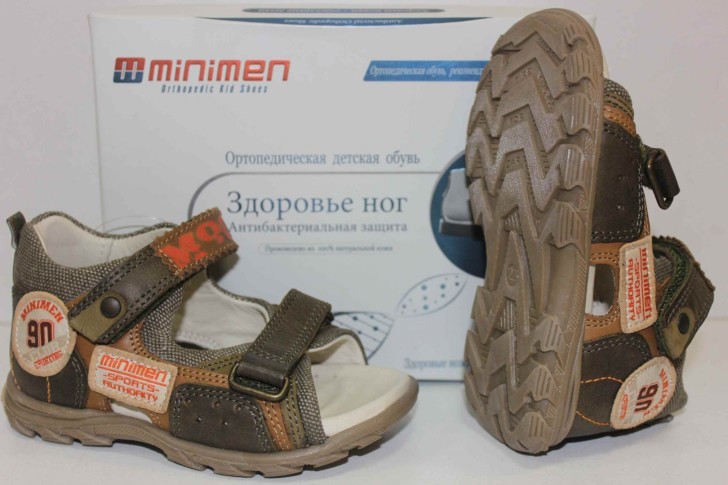 Orthopedic shoes are designed specifically to maintain healthy feet
Orthopedic shoes are designed specifically to maintain healthy feet By season:
- summer;
- winter;
- demi-season.
By appearance:
- closed;
- open;
- to the ankle;
- above the ankle.
Shoes for children must meet the following requirements:
- natural material that allows the foot to breathe (leather, textiles, nubuck, suede);
- flexible but elastic sole allows the leg to bend freely and follow the movements of the foot;
- textured anti-slip sole;
- a small heel is necessary to prevent flat feet and proper development of the leg;
- the presence of arch supports in children’s shoes and, if necessary, in shoes for older children;
- For the youngest customers, sandals or boots with Velcro are suitable.
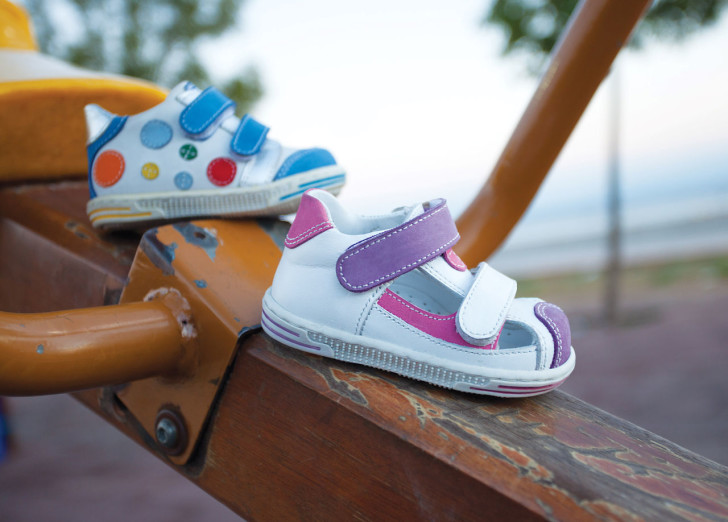 Leather shoes with a comfortable last and arch support have proven themselves best.
Leather shoes with a comfortable last and arch support have proven themselves best. Measuring the leg correctly
You can determine the correct shoe size for your child as follows:
- One of win-win options: take an insole from the shoes in which the child walks now and feels comfortable in it. The insole is measured and the size is determined.
- Measuring with a pencil on paper is also very effective. The foot is placed on a hard, flat surface and outlined with a pencil. You should first put on a sock. To buy shoes for the winter - warm, and for the summer - thin.
- It is possible to measure the foot using a ruler while standing on a flat surface.
- The most protruding parts of the foot are taken as the starting and ending points of measurement.
- The child can be placed on a ruler lying on the floor or on a pre-tensioned measuring tape.
- Measuring diagonally is incorrect.
- The leg swells a little during the day, so it is advisable to take all measurements in the afternoon.
- Be sure to measure both feet and use the larger foot as a basis.
- Right and left leg may differ by several millimeters.
- All roundings must be made upward. For example, with a length of 15.3, round up to 15.5, and with a length of 16.8, round up to 17 centimeters.
- It is imperative to take into account the reserve for growth and lengthening of the leg when walking. The total allowance should be about 15 mm.
- When choosing, do not forget to pay attention to the rise and thickness of the leg, especially for models with a zipper. Sneakers, sandals and shoes are usually easier to “adjust” to the desired volume, thanks to the available Velcro. For chubby legs, you should choose wide, spacious models, and for thin legs, narrower ones, which will allow the material to closely match the shape of the leg.
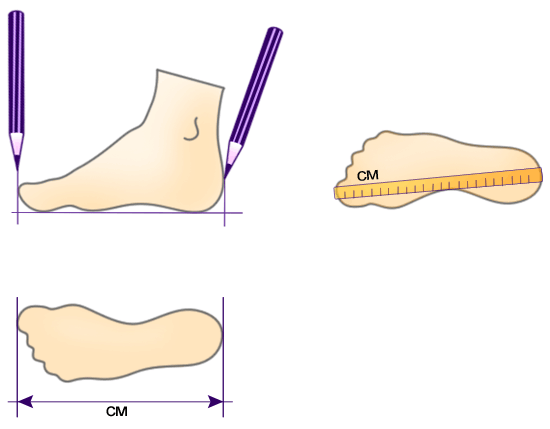 Simple scheme measuring a child's legs
Simple scheme measuring a child's legs The insole obtained as a result of measurements will allow you to accurately determine the size of the child’s foot in different systems measurements. The choice of table is determined by the country of origin. Tables are usually available in every shoe store, but you may want to take them with you so you can find your way around.
Sizing systems in different countries
The following dimensional systems are available today:
- The metric system used in Russia is compiled according to International standard ISO 3355-77. Here the size corresponds to the length of the foot in millimeters. For convenience, all indicators are rounded to 0.5 cm. The distance from the protruding (usually thumb) toe to the heel will be an indicative value. There are no additional amendments regarding the shape of the block, so this system is the simplest and most understandable. The size interval in Russian shoes is 0.5 cm.
- The stichmass (European) system is used for imported shoes. The unit of measurement for the length of the insole (and size, respectively) is taken to be 6.7 mm. It is taken into account that the insole, as a rule, is longer than the foot by about 15 mm. This is due to the fact that there is a margin for allowance in the length of the insole. This nuance is the reason for incorrect conversions of sizes from one system to another.
- English shoes are measured in inches, where an inch is equal to 2.54 centimeters. Newborn baby booties are size 0. Measurement is taken 4 inches from the heel. Spacing between dimensions is 1/3 inch.
- The Chinese measurement system follows the Russian one and takes as a basis the distance from toe to heel.
- The system in the USA, Canada and Australia is also measured in inches. The shift goes towards zero by 1/12 (2.1 mm).
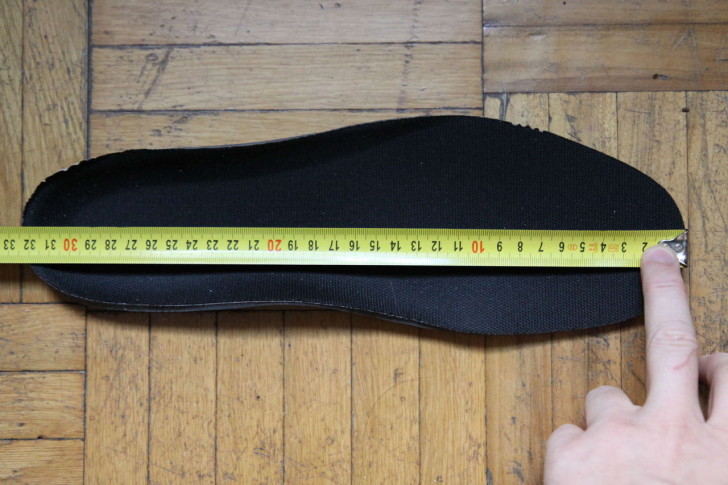 Chinese and Russian system uses a sizing chart corresponding to the length of the foot in centimeters
Chinese and Russian system uses a sizing chart corresponding to the length of the foot in centimeters Based on the standard size system, so popular today, you can set the following size of a child’s feet by month: from 6 to 9 months - number 17; from 9 to 12 months – number 18; For one year old child– 19-21 number.
It often happens that a girl’s leg at this age has a lower indicator (18 or even less). When choosing winter shoes, sizes from 20 to 23 are considered. You can select the exact size of a child’s feet using the tables.
Sizing charts
Table 1. Correspondence between the sizes of the metric and weight systems of children's shoe sizes
| Booties | Nursery | Malodetskaya | |||
|---|---|---|---|---|---|
| metric (cm) | Shtikhmas. | metric (cm) | Shtikhmas. | metric (cm) | Shtikhmas. |
| 9.5 | 16 | 10.5 | 17 | 14.5 | 23 |
| 10 | 16.5 | 11 | 18 | 15 | 24 |
| 10.5 | 17 | 11.5 | 19 | 15.5 | 25 |
| 11 | 18 | 12 | 19.5 | 16 | 25.5 |
| 11.5 | 19 | 12.5 | 20 | 16.5 | 26 |
| 12 | 19.5 | 13 | 21 | ||
| 12.5 | 20 | 13.5 | 22 | ||
| 14.5 | 22.5 | ||||
| Preschool | School | Teenage | |||
|---|---|---|---|---|---|
| metric (cm) | Shtikhmas. | metric (cm) | Shtikhmas. | metric (cm) | Shtikhmas. |
| 17 | 27 | 20.5 | 32 | 24.5 | 38 |
| 17.5 | 28 | 21 | 33 | 25 | 39 |
| 18 | 28.5 | 21.5 | 34 | 25.5 | 40 |
| 18.5 | 29 | 22 | 34.5 | 26 | 40.5 |
| 19 | 30 | 22.5 | 35 | 26.5 | 41 |
| 19.5 | 31 | 23 | 36 | 27 | 42 |
| 20.5 | 31.5 | 23.5 | 37 | 27.5 | 43 |
| 24 | 37.5 | 28.5 | 43.5 | ||
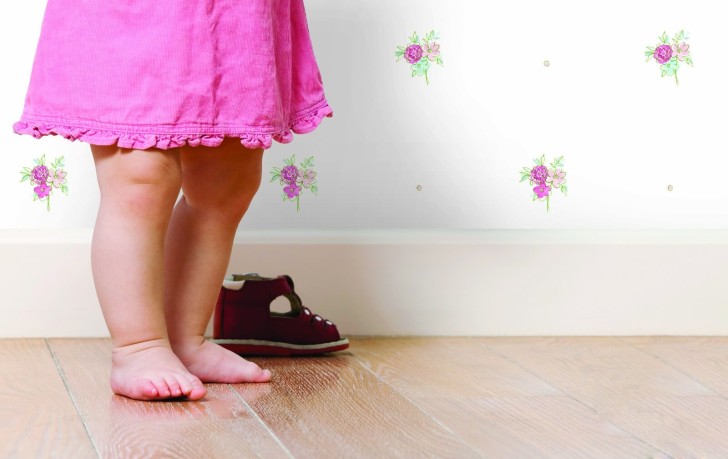 For chubby feet, you need to choose shoes of the appropriate width.
For chubby feet, you need to choose shoes of the appropriate width. Table 2. Shoe sizes for children by month up to one year
| Age | Foot length, cm | Foot length, inch | Russia | Europe | USA | China |
|---|---|---|---|---|---|---|
| 0-3 months | 9.5 | 3.7 | 10 | 16 - 17 | 0 - 2 | 10 |
| 0-6 months | 10.5 | 4.1 | 11 | 17 - 18 | 2,5 - 3,5 | 11 |
| 6-12 months | 11.7 | 4.6 | 12 | 19 - 19,5 | 4 - 4,5 | 12 |
Table 3. Shoe sizes for children from 0 to 6 years old
| Insole length, cm (+ 1.5 cm) | Russia / Europe | England | USA | |||
|---|---|---|---|---|---|---|
| 9 | 16 | 0.5 | 1 | |||
| 9.5 | 17 | 1 | 2 | |||
| 10.5 | 18 | 2 | 3 | |||
| 11.5 | 19 | 3 | 4 | |||
| 12 | 20 | 4 | 5 | |||
| 13 | 22 | 5 | 6 | |||
| 14 | 23 | 6 | 7 | |||
| 14.5 | 24 | 7 | 8 | |||
| 15.5 | 25 | 8 | 9 | Insole length, cmRussia / Europe | England | USA |
| 19 | 32 | 13 | 1 | |||
| 20.5 | 33 | 1 | 2 | |||
| 21.5 | 34 | 2 | 3 | |||
| 22 | 36 | 3 | 4 | |||
| 23 | 37 | 4 | 5 | |||
| 24 | 38 | 5 | 6 | |||
| 25 | 39 | 6 | 7 |
At the age of 10, the sizes of boys and girls are already very different. From this age, all sizes are divided into men's and women's.
Table 5. Teenage women's shoes from 10 years
| Insole length, cm (+ 1.5 cm) | Russia / Europe | England | USA |
|---|---|---|---|
| 21 | 35 | 2 | 4 |
| 21.5 | 35-36 | 3 | 5 |
| 22.5 | 36-37 | 4 | 6 |
| 23.5 | 37-38 | 5 | 7 |
| 24 | 38-39 | 6 | 8 |
| 25 | 39-40 | 7 | 9 |
| 26 | 40-41 | 8 | 10 |
| 27 | 41-42 | 9 | 11 |
| 27.5 | 42-43 | 10 | 12 |
Table 6. Teenage men's footwear from 10 years
| Insole length, cm (+ 1.5 cm) | Russia / Europe | England | USA |
|---|---|---|---|
| 23.5 | 39 | 4 | 6 |
| 24.5 | 40 | 6.5 | 7 |
| 25.5 | 41 | 7.5 | 8 |
| 26 | 42 | 8.5 | 9 |
| 27 | 43 | 9.5 | 10 |
| 28 | 44 | 10.5 | 11 |
| 28.5 | 45 | 11.5 | 12 |
| 29.5 | 46 | 12.5 | 13 |
| 30 | 47 | 13.5 | 14 |
| 31 | 48 | 14.5 | 15 |
| 32 | 49 | 15.5 | 16 |
Defining tight shoes
Only an older child can tell parents that shoes are pressing, pinching or causing other discomfort. Babies under one or even two years old will not be able to talk about this - how can mother know when it’s time to buy larger size or not yet? Use the following tips:
- After wearing closed shoes, you need to perform an external examination of the lower extremities. Noticing redness on the fingers, bent toes or other deformities, you can understand that the shoes are small either in width or in length.
- Check by pressing your finger on the toe. Between thumb and the edge of shoes, including winter ones, should have a small space. Normally for babies it is 1.5 cm.
- Take a closer look at the back of the shoe. When the shoe is small, the heel will be stretched. It will protrude from the back, on the outside of the shoe.
- The upper part of the boots also requires analysis. Comfortable shoes require a small gap between the tongue and the body. An overly tight and tight top is unacceptable.
Knowing that children’s feet grow very quickly throughout the year, they should be re-measured regularly. For babies up to the age of 1.5 years, this should be done once every three months, for children from 3 to 7 years old - once every six months, for children over 7 years old - once a year. Adolescence can be accompanied by rapid foot growth, so be sure to check for size increases in time. Genetic predisposition also occurs, as well as dependence on height and build.
When planning to buy shoes for your child, you need to remember important rules. The size of a child’s feet by age is a subjective concept. It is much more important to consider the length of the foot. Correctly measuring the distance from toe to heel is the key to a successful choice. Keep in mind that each manufacturer may have its own nuances in the size range.
IN There are 4 common size scales for children's and adult shoes in the world. For unknown reasons, European sizes have not been standardized, so the inside length of the shoe may not correspond to the sole length. Also important will be the indicator of the fullness of your child’s legs.
This must be remembered and do a fitting directly in the store.
Children's sizes among Americans, Europeans and Asians differ significantly from Russian ones. They are important to consider if you are planning to purchase shoes from a foreign manufacturer.
* Europe: it includes countries such as Germany, Italy, Poland, Lithuania, Latvia.
* USA,England: in America and Great Britain the scale reaches 13 and starts counting again from one.
In addition to these criteria, it is also important to take into account the length of the child’s feet, because each of them develops individually, and not all children have body proportions that match the standards.
Therefore, in order not to be mistaken with the size, measure the required length along the insole before purchasing. To do this, place your baby's foot on a piece of paper and trace it with a pencil. Then measure the length of the resulting trace.
It is very important to leave a small space free, since when walking the foot lengthens. In addition, a child's foot grows very quickly, and the baby cannot always tell you that the shoes have become too small for him. Every time you choose shoes for your baby, leave an allowance of 15 mm for the toe area.
Once you have decided on the size, you can start choosing a brand. There are several leading manufacturers of children's shoes. Read below about the features of their size scale.
Children's shoe sizes by brand
"Antelope"
The company has existed since 1998.
Firm "Antelope" except ready-made children's shoes also offers the production of corrective insoles for legs prone to flat feet. To do this, the child’s foot needs to be scanned in one of the company’s stores and insoles must be ordered. Judging by the reviews, the service was useful to many and saved more than one pair of legs.
"Zebra"
RussianThis company offers a wide range of shoes for children from one to 14 years old, i.e. You won't find shoes for newborns here..
However, these shoes have a number of advantages: environmentally friendly materials, latest developments taking into account the Russian climate and the orthopedic needs of the child’s body.
Start of production - 1936.
"Kotofey" offers the widest range of sizes: from booties for toddlers (from birth) to shoes for adults (sizes 40-45), as well as big choice colors, materials and styles.
The size range of "Antelope", "Zebra" and "Kotofey" corresponds to the column of Russian sizes.
Adidas
 It emerged as an independent brand in the late 40s of the last century. Supports sizing charts in Russia and England.
It emerged as an independent brand in the late 40s of the last century. Supports sizing charts in Russia and England.
A special feature of Adidas children's shoes is their exclusively sporty styles. You won't find any bows, rhinestones or ribbons on them. However, it should be noted that Adidas knows a lot about shoes for those who are constantly on the move.
"Nike"
The brand has existed since 1948. R The size range corresponds to US standards (see first table).
Like Adidas, Nike shoes are presented only in sports styles. Its main advantage is its lightweight, almost airy sole, designed for those who like to run.
"Fairy tale"
![]() This Chinese one trademark offers a large selection of different styles and colors, as well as shoes for any season. Another undoubted advantage is the affordable price.
This Chinese one trademark offers a large selection of different styles and colors, as well as shoes for any season. Another undoubted advantage is the affordable price.
Size ranges are presented from nursery (according to Russian sizes) to school age.
"Minimen"
 According to the manufacturer, Turkish Minimen shoes are made exclusively from genuine leather, and also takes into account the orthopedic features of the child’s foot. The sole is lightweight, so the shoe itself does not burden the movement of the first steps.
According to the manufacturer, Turkish Minimen shoes are made exclusively from genuine leather, and also takes into account the orthopedic features of the child’s foot. The sole is lightweight, so the shoe itself does not burden the movement of the first steps.
The size chart is designed for children from 0 to 14 years old (Europe).
For the youngest buyers there is a separate section on our website
Almost all children have healthy legs from birth, which will subsequently develop completely, but parents should definitely know what a limb should look like at a given age. This is extremely important, because legs are often bent due to uncomfortable shoes, which is fraught with troubles in adulthood. So, let's take a closer look at what a child's foot should look like by month.
Peculiarities of childhood
Young children have cartilage tissue in their bodies instead of hard bones. This is provided for by nature itself, because children often injure themselves in the process of learning about the world. A child can easily fall on his buttocks and not get the slightest bruise, while for an adult such a fall can end up in the trauma department.
During the first few years, cartilage gradually forms and transforms into bone tissue. In particular, on the feet, so it is necessary to approach the choice of shoes as carefully as possible, so that in the future the incorrect development of the form does not bring suffering to the grown child.
Until a certain period, parents themselves may not even suspect such a disorder, because it manifests itself either in adolescence or in middle age. As a rule, a person with improperly constructed legs begins to periodically feel discomfort; sometimes the so-called “bones” can protrude, and in this case it becomes extremely difficult to choose shoes.
In order to prevent such problems, it is necessary to visit an orthopedist at least once a year from the age of five to make sure that the child’s legs are growing correctly and that parents have no reason to worry.
Leg by month
Young mothers should know that in the first 2 years, the length of a newborn’s leg grows by about 4 cm. In the next 2 years, it will grow by another 2.5-3 cm. Subsequent growth will occur by approximately 1 cm per year until the age of 14. Next, for another 4 years, the structure of the structure will change until it is finally established at approximately the age of 18 years. There is a wonderful table that clearly shows what size a child’s feet are.
As you can see, the size of a child’s foot increases by literally 2.2 cm up to one year old, that is, at 12 months the baby’s foot is 11.7 cm. Subsequently, such rapid growth is no longer observed, the foot slows down in growth, and by the age of 5 it is almost equal to 18 and a half cm.
This table should not be taken as a guide. Whatever foot size your baby has, remember that all children are different and must develop independently. This is a natural process. One baby’s leg will grow by 2 cm in a year, another – by 2.5 cm, and there is no reason to worry.
Common mistakes parents make
Experienced mothers are aware that the process of selecting children's shoes is a whole show, where much depends on parental intelligence and good reaction. The fact is that when choosing, little children, in principle, cannot be guided by the same criteria as adults.
The problem is not capriciousness, but the fact that babies do not immediately feel how comfortable it will be for them to walk. A child’s leg still mainly consists of a layer of fat and soft cartilage, which easily bend under the conditions external environment. That is, a baby can easily walk in uncomfortable shoes, not realizing what this will mean for him in the future.
Usually, when choosing shoes for a child, parents allow 4 main mistakes:
- The fitting takes place this way - the mother puts the sandal/shoe on the baby and asks: “does it feel too tight?” or “doesn’t it press anywhere?” - this is a wrong approach. Naturally, the child answers negatively. He will object even if he tries on the “Spanish boot” (an instrument of torture in the Middle Ages). As mentioned above, children do not understand when shoes are tight or uncomfortable for them - their feet are still in the process of developing, therefore, the sensitivity threshold is quite low.
- Buying shoes with a cartoon character. Bright things attract children, so your little one can easily deceive you by saying that the shoes are just right for him in order to get beautiful shoes. You shouldn’t focus on children’s opinions, they are really biased.
- Fitting the shoe to the foot. This is a mistake, because the outside of the sandal can be much larger than the inside.
- Buying shoes on the fly. You can’t buy such things for children, because they grow up quickly. Within a week, your purchase will turn out to be too small, and you will have to throw it away or give it to someone else. Always buy shoes 1-2 sizes larger, in which case they will last for the season.
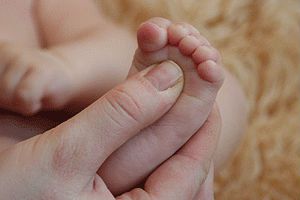
The foot may be damaged by wearing improperly fitted shoes.
There are several features that mothers should definitely know about. For example, buying winter shoes, it should be taken into account that the foot will also have a thick sock, so such things should be bought at least 2 sizes larger.
When purchasing shoes, you should not determine its comfort by sticking two fingers into the heel. The baby will simply tighten his toes, and you will mistakenly think that the sandals will fit him.
How to buy the right shoes
The ideal option is to try on the shoes yourself at home and go shopping with the results of your measurements. In this case, you will quickly and efficiently choose an item without resorting to the baby’s opinion.
Let's take it Blank sheet paper and a thin marker. Carefully place the child’s foot on the piece of paper, trying to press it tightly, and trace it along the contour. It is advisable that the marker is not thick, as this may distort the result. When drawing an outline, follow your hand in a circle, otherwise inner side will be carried out incorrectly.
The procedure should be carried out in evening hours, When blood vessels relax and become expanded. The best time to draw is after swimming. This will help prevent you from buying tight shoes.
The measures taken will help you avoid common mistakes and choose the perfect shoes for your baby. Naturally, it is better to choose a bright, attractive thing that will pleasantly please the child, rather than something gray and shapeless. The main thing is not to buy expensive branded products, children grow quickly, and an expensive purchase will be unnecessary in a few months.
Choosing shoes is always a responsible task, because not only the correct gait depends on it little man, the development of the foot, but also his mood. In order for the purchase of boots, sandals, slippers or shoes to be successful, first of all, you should decide on the size of the baby’s feet.
How does a child's foot length change by month?
A newborn’s foot goes through several stages of formation as it grows, so it is advisable for parents to closely monitor changes in the baby’s foot. It is extremely important to know what a limb looks like at a given age in order to prevent pathological changes. The size of children's feet by age is ambiguous - it is constantly changing. This is especially true for one-year-old toddlers, who need high-quality and suitable shoes no less than adults.
If you don't take care of your baby's feet right away, it can result in a number of serious orthopedic problems when he gets older. For the first few years, babies' feet consist of cartilage, which over the years turns into bone tissue. Modern shoes made taking into account the smallest anatomical features child's foot, which allows the leg to form correctly. To prevent problems, parents need to not only know exactly what size the child’s feet are by age and buy high-quality wardrobe items, but also visit an orthopedist after the child is five years old.
A baby's foot may grow unevenly, so it is recommended to monitor the size of the child's foot by age. From birth to one year and from one to three years, the value should be measured no more often than once every three months. During this time, the parameters of the foot change. At the age of three to six years, it is necessary to take measurements a little less often - once every four months. As for boys and girls from six to ten years old, their feet should be measured once every five months. This tip will help you monitor your child's foot growth and choose appropriate shoes.
The length of a child’s leg by age is determined as follows:
- It is best to measure the feet of infants with a tape measure or a string, which is then attached to a ruler. This is the easiest way to find out the foot size of newborns by month.
- For older children, the length of the foot is determined in a standing position. The legs should be placed on the paper, then traced around the edge with a pencil. You can wet your feet in water so that a wet mark remains on the sheet. Then you need to measure the length of both prints, add the data and divide in half. As a result, you will get a figure for precise definition foot size in children according to age, because feet may not be the same in length. You should focus on the parameters of the larger foot.
- Remember that in summer you should add half a centimeter to the size, taking into account that the leg may swell. IN winter period add one and a half, because it has to fit into the shoes warm sock and there will still be space for air circulation.
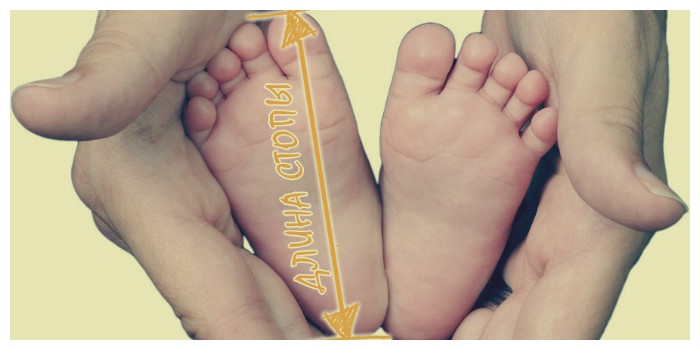
Baby's foot size by month
Each baby is individual, but in pediatrics there are generally established standards. They help parents monitor the growth and development of the baby. Foot size is no exception. Using the table below, you can easily find out the average foot length of your baby from birth to age five. To calculate your child’s foot size by month, use the following calculations:
| Foot length |
||
| centimeters | ||
| 0-3 months | ||
| 3-6 months | ||
| 6-12 months | ||
| 12-18 months | ||
| 18-24 months | ||
American and European shoe sizes by child's age
There are several scales that help determine shoe sizes for adults and children. European measurements have not led to uniform standards, so the ratio of the length of the sole and insole may not match. Consider the fullness of your baby’s feet so that the shoes are not too small. Remember that everyone develops individually, and body proportions often do not coincide with standards. IN Western Europe and the USA uses a mass scale for measuring the size of a child’s feet by age. On such shoes, the length along the inner insole is indicated in units (1 unit = 2/3 cm).
European measurement data applies to shoe manufacturers from Germany, Italy, Poland, Lithuania and Latvia. In England and the USA, the peak mark on the scale is thirteen, and then the countdown begins again. Foot length is measured in inches. Before purchasing shoes from a European or American manufacturer, be sure to measure the length of your child’s feet using the insole. Always leave an allowance of one and a half centimeters in the toe area, because the foot lengthens a little when walking.
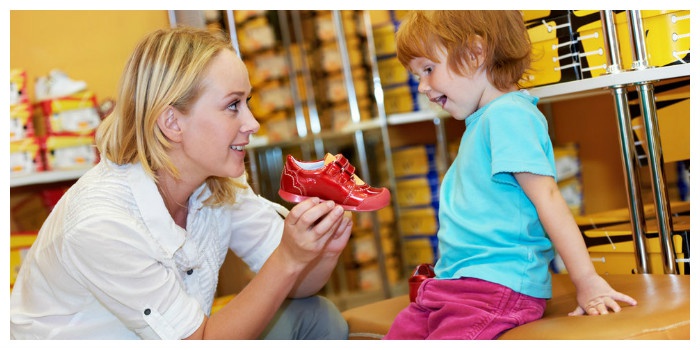
Russian shoe sizes for children by age
The modern Russian size grid for children's shoes will coincide with the European one. The scale is indicated in centimeters, and your baby's foot size is measured by extreme points: the most protruding part of the heel and the toe that comes forward, that is, the big one. Decorative allowances on shoes are not taken into account. Fast and easy way calculating all the necessary parameters - the correct measurement of the foot in millimeters.
For example, for babies from six to nine months, size seventeen is suitable, from nine to twelve months - eighteen-nineteen, from twelve to eighteen - size nineteen-twenty. As for booties, they range in size from sixteen to nineteen. The size of a child’s feet by month is easy to calculate thanks to generally accepted Russian standards.
Child's foot size chart
The size chart really helps parents choose the right shoes, shoes, slippers, sneakers, and sandals for their kids. The child's foot size for the specified age is in accordance with dimensional grid. This greatly simplifies the selection of products in the store. If you take into account the data of domestic and foreign manufacturers, you can accurately choose comfortable models of wardrobe items.
| Foot length | Metric system | Non-mass system | ||||
| Russian size | European size | US size | ||||
| centimeters | ||||||
| 0-3 months | ||||||
| 3-6 months | ||||||
| 6-12 months | ||||||
| 12-18 months | ||||||
| 18-24 months | ||||||
Video: shoe size by child’s age
Your baby is back on his feet! So, it's time to go to the store to buy him shoes. And here your task is to buy not only beautiful and high-quality shoes, but also to decide on the size of children's shoes, because your baby cannot answer for himself whether he is comfortable in them. Therefore, so that your child does not feel discomfort, but remains in good mood, It is important to know shoe size for children, table by age.
Shoe sizes for children from different countries
In our stores you can purchase children's shoes not only in different styles, but also from different manufacturing countries. And if you compare shoes for children in Russia, the USA, China and Europe, you will notice that their sizes are different. Therefore, in order not to get confused in all these numbers, it is worth using a table of children's shoe sizes by country of origin.
1. Child’s shoe size by age, table (Russia). In Russia, manufacturers use metric system sizes of children's shoes, that is, the length of the foot in mm is taken as a basis. Knowing the leg length in mm, you can find out the shoe size for a child by age, here we also offer table (Russia).
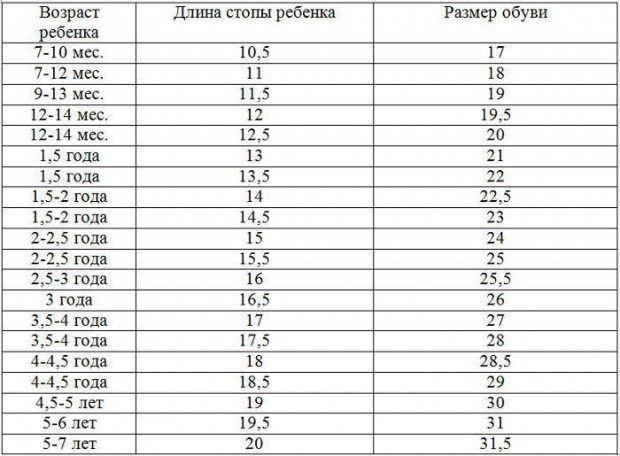
2. Child’s shoe size by age, table (USA). Here it is immediately worth noting that Americans divide children's shoes into categories: shoes for babies (infart), for preschoolers (kids) and for teenagers (youth). Each category has its own size, that is, size 7 will be different depending on age. Moreover, each designation is preceded by the letter “C” (children’s), because in the USA shoe sizes end at 13.5, and then start again at one.
Child's shoe size by age, table (USA)
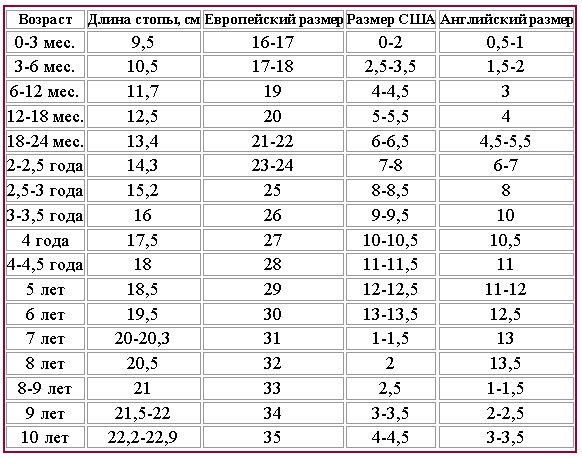
3. Child’s shoe size by age, table (China). Everything is simple here, since children's shoes from China are measured in cm, just like in Russia.
Child's shoe size by age, table (China)
4. European sizes shoes for children. In European countries, the unit of measurement for children's shoes is 2/3 cm, that is, 6.7 mm. The length of the insole is 1-1.5 mm longer than in domestic shoes, that is, if you need size 16, you buy 17.
As you noticed, each manufacturing country uses its own designation for children's shoe sizes.
How to measure a child's foot correctly
Of course, knowing shoe size for children, table by age cm, you can choose the right shoes for your baby. But before you look at the table, you first need to correctly measure your child’s foot. In order to take accurate measurements of a child's foot, you need to take a piece of paper, put it on the floor and place your baby on it so that he rests his foot completely on the paper and straightens his toes.













